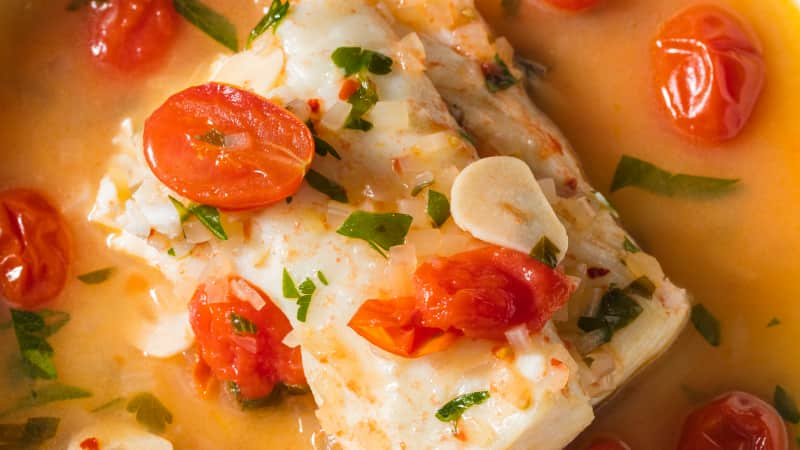In the early 1800s salt was scarce, even along Italy’s southern coast. So hungry fishermen came up with a “crazy”—and frugal—idea: stewing their catch in seawater. That’s just one story behind pesce all’acqua pazza (“fish in crazy water”), which, over time, evolved considerably into a dish featuring firm‑fleshed white fish cooked in a tomato-studded, garlic-infused broth.
Southern Italian Poached Fish
Published June 1, 2021.

To learn more about acqua pazza, I consulted naturalist and Italian food authority Eugenia Bone. Interestingly, her exceedingly simple formula was nearly identical to that of another source I queried, my Sicilian friend Vito Aluia, an accomplished cook. We prepared his family recipe together: Warm garlic in olive oil; add water, salt, tomato, and parsley; and then gently poach whole whiting—an inexpensive fish with sweet, mild flesh—in the seasoned liquid until it turns opaque.
The result was fresh-tasting and satisfying, with moist, flaky fish, and it was clear why both Bone and Aluia opted for whole fish: The collagen-rich skin contributed significant body to the broth. That said, not everyone can find whole fish.
Some cooks prepare the dish with skinless fillets, as they are nearly effortless to cook, but I missed the boost the skin had provided. Luckily, skin-on haddock (or a similar species) worked beautifully. The skin suffused the broth with plenty of silky richness along with notable flavor. To ensure perfectly cooked fillets, I poached them over low heat until they were nearly done and then slid the pan off the burner to finish them at a gentler pace.
Skin in the Game

The collagen in the fish skin breaks down as it cooks to form so much silky gelatin in the broth that when we refrigerated a portion, it set up like Jell-O.
With the fish settled, I fine-tuned the water-based broth, kicking things off with thinly sliced garlic cooked in extra-virgin olive oil. For the tomatoes, restraint proved important so that the dish would be accentuated—not dominated—by sweet, colorful pops. Cherry or grape tomatoes are reliably flavorful year-round, which gave them the edge here; I halved them to release their juices. Many cooks spike the water with dry white wine, and I found that its faint acidity allowed the haddock to shine. A sprinkle of chopped parsley followed, and I also tossed in the stems to eke out every bit of goodness the herb had to offer.
Additional ingredients from the Italian larder were open to improvisation. Fresh or dried chiles, anchovies, lemons, oregano, thyme, bay leaves, capers, and olives all make appearances in other recipes, as do onions, leeks, fennel, and carrots. After working through the list, I realized I preferred uncomplicated versions. I opted for red pepper flakes for a spark of heat, a bay leaf for a base herbal note, and onion for subtle sweetness. The resulting broth was light, clean‑tasting, and redolent of garlic and tomato.

Lastly, I followed the lead of many cooks and came up with a variation that gives the dish a bit more heft by increasing the amount of liquid and adding a fistful of angel hair, broken into short lengths. In my view, pasta is welcome in nearly every circumstance, and it’s a terrific option here, too.

